Bicycle crunches are a fantastic way to engage your core muscles and sculpt those longed-for six-pack abs. Or at least that is what people instantly think of — but there is so much more to them. This exercise also targets your obliques, hip flexors, and lower back. It’s like a full-body cycling adventure right in the comfort of your own workout space.
This super functional exercise is easy to incorporate into your everyday workout program. Bicycle crunches mimic the movement patterns of bicycle riding, hence the name.
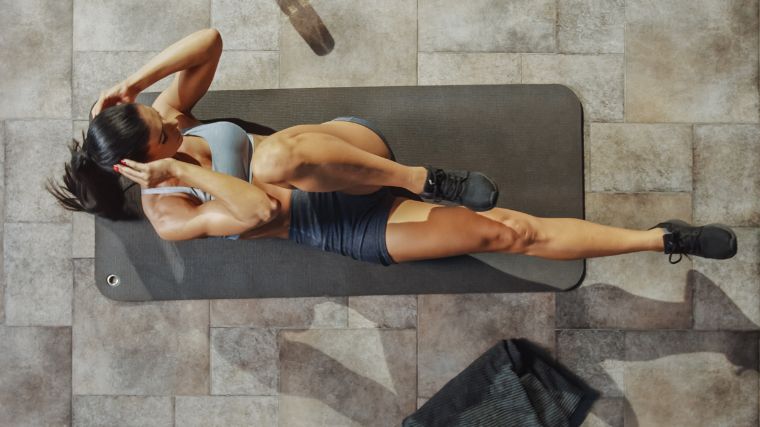
By performing this bodyweight exercise, you activate both your upper and lower body, which engages your abdominal muscles and hip flexors while improving coordination and balance. Here’s how to get cranking on some bicycle crunches and strengthen your core and hips in the process.
- How to Do the Bicycle Crunch
- Bicycle Crunch Variations
- Bicycle Crunch Alternatives
- Bicycle Crunch Tips
- Bicycle Crunch Sets and Reps
- Benefits of the Bicycle Crunch
- Muscles Worked by the Bicycle Crunch
- Who Should Do the Bicycle Crunch
- Common Bicycle Crunch Mistakes
- Frequently Asked Questions
Editor’s Note: The content on BarBend is meant to be informative in nature, but it should not be taken as medical advice. When starting a new training regimen and/or diet, it is always a good idea to consult with a trusted medical professional. We are not a medical resource. The opinions and articles on this site are not intended for use as diagnosis, prevention, and/or treatment of health problems. They are not substitutes for consulting a qualified medical professional.
How to Do the Bicycle Crunch
So, how does it work? Doing bicycle crunches is fairly easy. All you need is clear instructions and a comfortable and spacious workout space. You also must remember to maintain proper form and fully engage your core muscles. It may feel challenging at first, but you will get more comfortable over time.
Step 1 — Get Horizontal
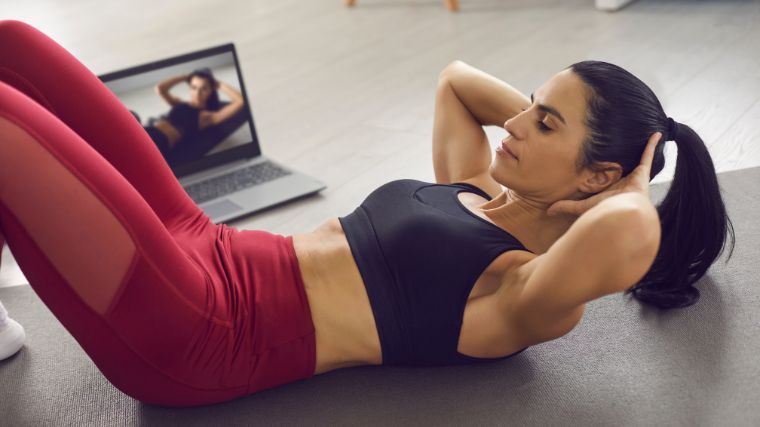
First, you will want to lie on the floor flat on your back, then lift your shoulders off the ground and place your hands behind your head.
Coach’s Tip: Ensure you have enough space to lie down comfortably. You may also consider lying on an exercise mat for a more comfortable experience.
Step 2 — Knee-to-Elbow
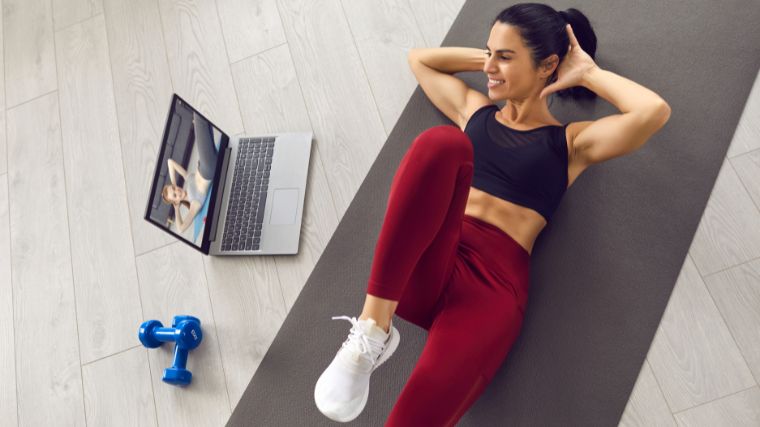
Next, bring your right knee towards your chest while simultaneously rotating your left shoulder and elbow towards it. This is a cross-body, or contralateral, movement.
Coach’s Tip: Attempting to touch your opposite elbow to your knee tends to be helpful. This helps encourage the correct movement.
Step 3 — Repeat!
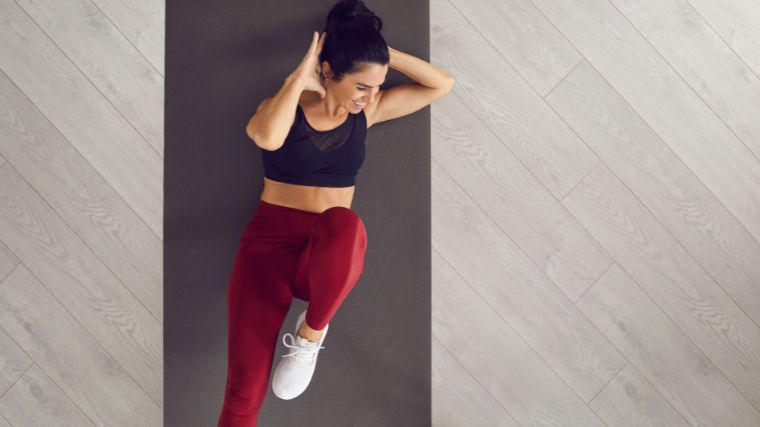
Continue this pedaling motion, alternating sides, as if riding a bicycle. Be sure to keep your shoulders and feet elevated off of the ground the entire time.
Coach’s Tip: As you move, think, “Right knee, left elbow. Left knee, right elbow.” While you may need to rest after a few reps, keep your core tight and your lower back pressed into the floor.
Bicycle Crunch Variations
Bicycle crunches are fairly straightforward, but if you are looking for an alternative to the movement for one reason or another, here are a few options.
Standing Bicycle Crunch
[Read More: 5 At-Home Workouts for Strength, Muscle Growth, Power, and More]
- Stand upright with your feet shoulder-width apart and your hands behind your head.
- Lift your right knee towards your left elbow, twisting your torso and engaging your obliques.
- Return to the starting position and repeat on the other side. This standing variation engages your core while also challenging your balance and coordination.
Weighted Bicycle Crunch
[Read More: Nutrition for Athletes — How to Eat for Muscle and Performance]
- Lie flat on the floor on your back, lift your shoulders off the ground, and hold a dumbbell or medicine ball in your hands.
- With the weight in hand, engage your core and bring your right knee towards your right elbow, aiming to touch them together.
- Return to the starting position and repeat with the left knee and left elbow. Continue alternating sides.
Reverse Bicycle Crunch
[Read More: The Best Online Workout Programs For Coaching, Cardio, Value, And More]
- Lie flat on the floor on your back, and lift your shoulders off the ground.
- Instead of bringing your right knee towards your chest while rotating your left shoulder, reverse the movement.
- Bring your left knee towards your chest while rotating your right shoulder, and vice versa.
Bicycle Crunch Alternatives
Several core exercises are similar to bicycle crunches and work the same muscle groups or close to them. Some people may feel intimidated by doing core work that requires lying flat on the floor and performing a crunching motion. Luckily many exercises work your core but allow you to position your body differently than stereotypical core work does.
Mountain Climber
[Read More: The Complete Guide to Pre-Workout Supplements]
- Begin in a high plank position with your hands directly under your shoulders.
- Engage your core and bring one knee towards your chest, then quickly switch legs, bringing the other knee towards your chest while extending the opposite leg back.
- Continue alternating legs in a running motion while maintaining a strong plank position.
Plank with Knee-to-Elbow
[Read More: The 15 Best Shoulder Exercises For Building Muscle]
- Begin in a high plank position with your hands directly under your shoulders and your body in a straight line.
- Engage your core and bring your right knee towards your right elbow, aiming to touch them together.
- Return to the starting position and repeat with the left knee and left elbow. Continue alternating sides.
Russian Twist
[Read More: Best Supplements for Muscle Growth]
- Sit on the ground with your knees bent and feet flat.
- Lean back slightly and lift your feet off the ground, balancing on your tailbone.
- Hold your hands together or hold a weight in front of your chest. Twist your torso to the right, bringing your hands or the weight towards the right side of your body. Return to the center and then twist to the left side. Continue alternating sides.
Bicycle Crunch Tips
The bicycle crunch may be a fairly basic movement, but you can still optimize your performance to get slightly better results. Here are a couple of quick tips to help you out:
Use a Mat
You shouldn’t be distracted by an uncomfy or dirty floor during bicycle crunches. Laying down on a yoga mat will give you some padding under your hips. This should allow you to stay focused on what matters — executing picture-perfect repetitions.
Breathe as You Move
Strive to match your breathing patterns with your movement during the bicycle crunch. As you draw your arm toward your knee, exhale sharply (this will also help you contract your abs a bit more). Then, as you release and change limbs, inhale a fresh breath. Matching your inhalation and exhalation to each rep will put your breathing on autopilot.
Bicycle Crunch Sets and Reps
Bicycle crunches are a versatile exercise that can be adjusted to meet different goals through rep variance. As the bicycle crunch is an unloaded exercise by default, most folks opt for higher reps with controlled form for muscular endurance.
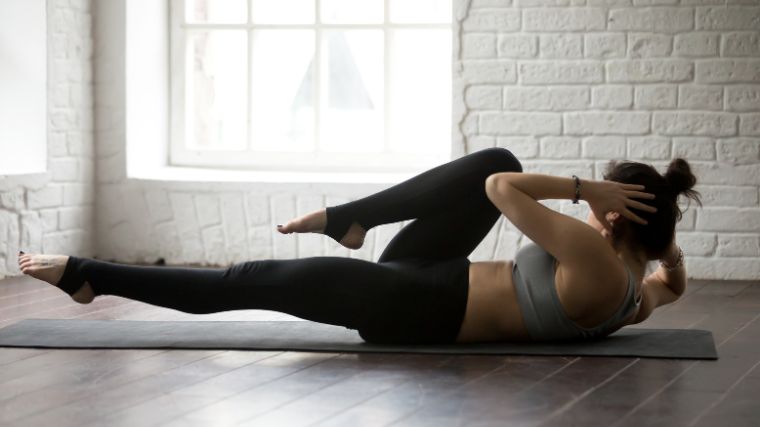
[Read More: The Gymgoer’s Guide to Whey Protein]
Lower rep ranges with added resistance, such as holding a weight plate or using resistance bands, can help increase strength and muscle hypertrophy. All that said, bicycle crunches may not be ideal for maximal strength development due to limitations in loading options.
- For Muscle Mass: Perform four sets of 8-10 reps, holding a weight that allows you to complete each but being greatly challenged with the last rep or two of each set.
- For Strength: Do three sets of five reps, using extra resistance. Try adding a looped resistance band around your feet for added resistance.
- For Endurance: Set a timer for 5 minutes and perform 15-20 reps at the start of each minute. Rest for the remainder of the minute. Repeat this cycle for the entire set. This is known as an EMOM, every minute on the minute.
Benefits of the Bicycle Crunch
Bicycle crunches are effective because they target multiple muscle groups simultaneously, helping you burn calories and strengthen your core. They offer many benefits for improving your physique, strength, performance, and flexibility. Here’s what you stand to gain from the bicycle crunch:
Sculpts and Defines the Core
Bicycle crunches sculpt and define the core by engaging multiple core muscles, including the rectus abdominis and obliques. The twisting and pedaling motion of bicycle crunches activates the upper and lower abs, contributing to muscular hypertrophy in those areas.
The engagement of the obliques helps create definition along the sides of the waist. However, note that consistency, proper form, and especially an appropriate diet are essential for achieving noticeable results and revealing a defined core.
Enhances Core Strength and Stability
If you want to enhance your core strength and stability, bicycle crunches are a great exercise to incorporate into your routine. Bicycle crunches enhance core strength and stability by engaging your core muscles to promote both strength and endurance.
The exercise requires core stabilization throughout the movement, activating deep stabilizing muscles and improving overall core stability. Proper execution of bicycle crunches supports spinal alignment and postural control as well.
The functional integration of the exercise replicates movements encountered in daily activities and sports, enhancing core strength and stability for various functional fitness movements. Consistent practice and progression are important for maximizing the benefits of bicycle crunches for core strength and stability.
Promotes Flexibility
If you could benefit from more flexibility, bicycle crunches might be the answer. The twisting motion of the exercise helps increase your range of motion by relying on what’s called reciprocal inhibition. As the muscles on one side of your body contract, the others must relax and lengthen to accommodate the movement.
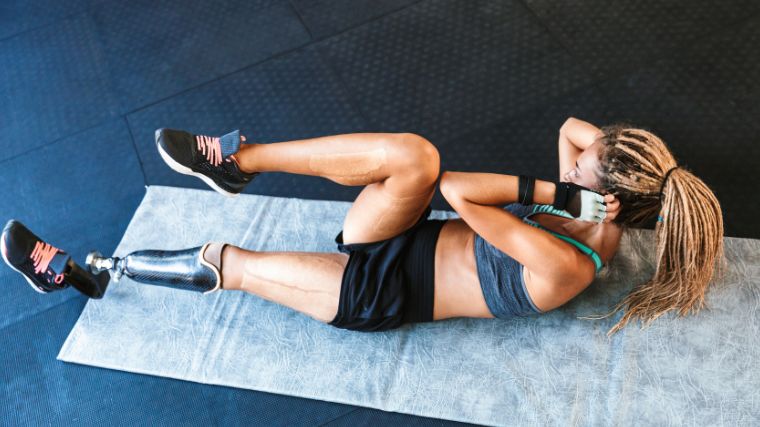
[Read More: Use the Bent-Over Row to Make Big Gains With Big Weights]
While primarily targeting core strength, incorporating bicycle crunches into a warm-up routine or overall flexibility program can contribute to improved flexibility in a controlled and functional manner.
Muscles Worked by the Bicycle Crunch
In bicycle crunches, several key muscles come into play, and understanding their involvement is important for maximizing the effectiveness of the exercise. These muscles include rectus abdominis, obliques, and transverse abdominals.
Rectus Abdominis
Located in the front of the abdomen, the rectus abdominis is commonly called the “six-pack” muscles. Your rectus abdominis flexes the spine and assists in the forward crunching motion during bicycle crunches.
Obliques
The obliques are located on the sides of the waist. There are two sets: the external obliques and the internal obliques. The external obliques are involved in the rotation and side-bending movements during bicycle crunches, while the internal obliques help stabilize the core.
Transverse Abdominis
The transverse abdominis is a deep core muscle that wraps around the abdomen, providing stability and support. It is crucial in maintaining core stability and controlling movements during bicycle crunches. Your transverse abdominis works hard in silence to preserve the integrity of your abdominal wall as you move your pelvis during the crunch.
Who Should Do the Bicycle Crunch
So who should you consider performing bicycle crunches? Bicycle crunches are great for beginners, CrossFitters, and Olympic Lifters: No matter your skill level, it is important to have good core strength.
Having a strong core not only helps athletes, but the everyday gymgoer as well. Anyone lifting and moving objects or people should have a strong core to prevent and mitigate injuries or accidents.
Beginners
Bicycle crunches benefit beginners due to their ability to strengthen the core, their low-impact nature, and their versatility in adapting to different fitness levels. They help develop core stability, define abdominal muscles, and can be performed conveniently with minimal equipment, which makes them easily accessible.
Beginners should start gradually, prioritize proper form, and seek guidance from fitness professionals for personalized instruction. For those aiming to develop defined abdominal muscles, bicycle crunches are a valuable addition to their ab workout routine. By targeting the rectus abdominis and obliques, bicycle crunches help strengthen and tone these muscles, potentially leading to a more sculpted midsection.
CrossFitters
Bicycle crunches offer several benefits for CrossFitters. They strengthen the core, providing stability and improving performance in functional movements found throughout CrossFit. This ab exercise efficiently targets the abdominal muscles, promoting definition and a well-rounded physique as well.
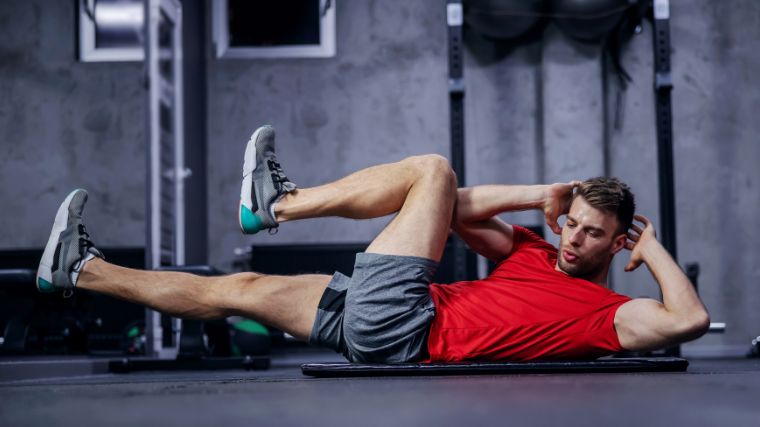
[Read More: The Best Foods for Energy Before, During, and After Your Workouts]
Bicycle crunches also enhance flexibility, midline control, and rotational strength, which are essential in CrossFit. They can also be used for conditioning and endurance training. The movement pattern of bicycle crunches transfers well to functional movements, aiding in power generation and stability.
Olympic Lifters
Olympic lifters can see several benefits from doing bicycle crunches. They improve core stability, trunk control, and positioning during explosive lifts. Bicycle crunches also enhance flexibility, mobility, and strengthen some of the movement patterns required for Olympic lifting such as hip flexion. They aid in transferring power from the lower body to the upper body and may contribute to injury prevention by strengthening the core muscles.
Bicycle crunches can also assist Olympic lifters in developing better body awareness and coordination. The rotational and pedaling motion of bicycle crunches requires coordination between the upper and lower body, which translates to improved motor control during the explosive movements of Olympic lifting.
Common Bicycle Crunch Mistakes
If you want to make the most out of your bicycle crunches, avoiding common mistakes is key. By understanding and avoiding mistakes, you can optimize the effectiveness of your bicycle crunches and ensure that you’re targeting the right muscles while minimizing the risk of injury.
Neck Strain
During the bicycle crunch, one common mistake is pulling on your neck with your hands. This can strain the neck muscles and shift the focus away from the core. Instead, place your hands lightly behind your head for support, and avoid actively pulling on your neck as a way of “forcing” more range of motion.
Excessive Speed
Rapidly performing bicycle crunches with momentum can reduce the effectiveness of the exercise. Slow, controlled movements allow for proper muscle engagement and ensure the core muscles do the work. Focus on quality and control rather than speed.
Incorrect Breathing
Neglecting proper breathing can hinder the effectiveness of bicycle crunches as well.
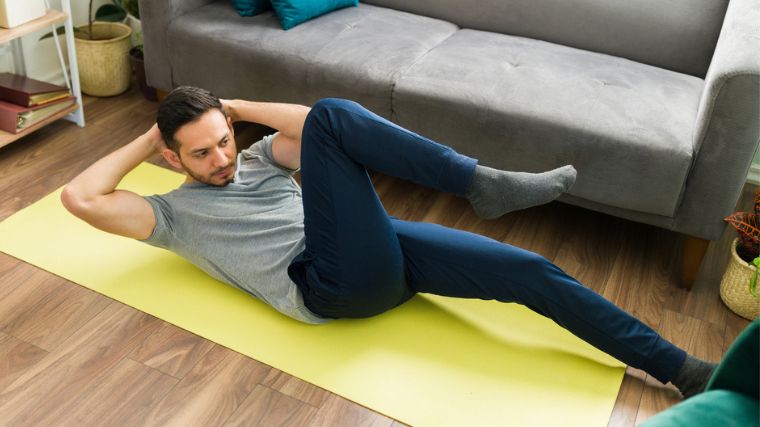
[Read More: The Best Full-Body Bodybuilding Workout for Beginner to Advanced Lifters]
Avoid holding your breath or breathing shallowly. Instead, breathe deeply and exhale as you twist, inhaling while returning to the starting position. This will allow you to retain enough cardiovascular endurance to complete high-quality, high-repetition sets.
Pedal to the Metal
Bicycle crunches are highly effective for targeting and strengthening the core muscles. They engage key muscles such as the rectus abdominis, obliques, and transverse abdominis, promoting core stability, strength, and endurance. They can contribute to sculpting and defining the abdominal muscles, improving posture, and enhancing overall athletic performance.
By incorporating bicycle crunches into a well-rounded fitness routine, you can develop a strong and stable core, improve flexibility, and perhaps even reduce the risk of lower back pain.
With consistency, proper form, and gradual progression, bicycle crunches can be a valuable addition to your fitness regimen, supporting your goals of a stronger, fitter, and more sculpted core. So hop on that imaginary bicycle and pedal your way to a stronger core and improve overall fitness!
FAQs
Still struggling to grasp everything behind the bicycle crunch? These frequently asked questions might have the answers.
How often should you do bicycle crunches?
The frequency of performing bicycle crunches depends on individual factors such as fitness level and goals. Generally, it is recommended to include them in your routine two to three times per week. Beginners can start with two weekly sessions and gradually increase frequency as they build strength and endurance.
What are the best ways to make bicycle crunches harder?
To make bicycle crunches more challenging, you can increase repetitions, slow down the tempo, add weight or resistance, focus on isometric holds, increase speed and intensity, and incorporate alternating variations.
Gradually progressing with these methods can enhance endurance, strength, and muscle development. However, it’s important to prioritize proper form and technique and listen to your body to avoid overexertion. Adjust the difficulty level based on your fitness level and goals to ensure a safe and effective workout.
Will bicycle crunches give you a six-pack?
Bicycle crunches alone will not give you a six-pack. Visible abdominal muscles are primarily influenced by reducing overall body fat through exercise, a balanced diet, and a calorie deficit.
While bicycle crunches effectively target the core, incorporating various core exercises and considering individual genetics are important factors in achieving a defined midsection. A comprehensive approach that includes both dietary changes and rigorous exercise will help you bring out those abs.
Featured Image: Gorodenkoff / Shutterstock